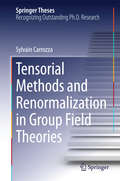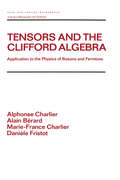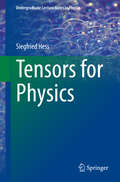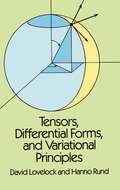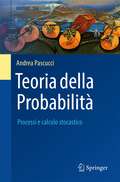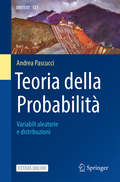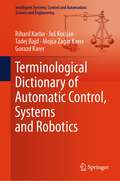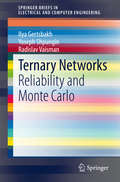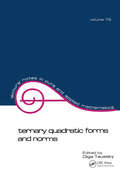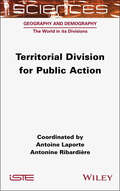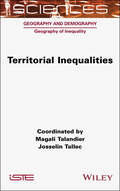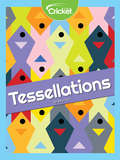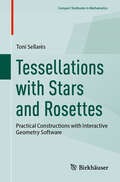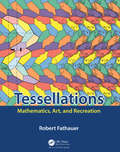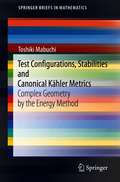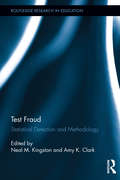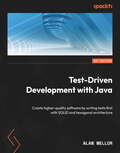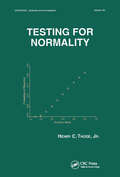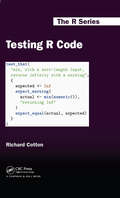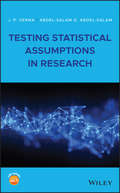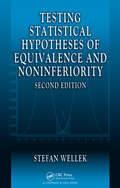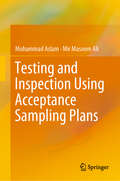- Table View
- List View
Tensorial Methods and Renormalization in Group Field Theories
by Sylvain CarrozzaThe main focus of this thesis is the mathematical structure of Group Field Theories (GFTs) from the point of view of renormalization theory. Such quantum field theories are found in approaches to quantum gravity related, on the one hand, to Loop Quantum Gravity (LQG) and on the other, to matrix- and tensor models. Background material on these topics, including conceptual and technical aspects, are introduced in the first chapters. The work then goes on to explain how the standard tools of Quantum Field Theory can be generalized to GFTs and exploited to study the large cut-off behaviour and renormalization group transformations of the latter. Among the new results derived in this context are a proof of renormalizability of a three-dimensional GFT with gauge group SU(2), which opens the way to applications of the formalism to quantum gravity.
Tensors and the Clifford Algebra: Application to the Physics of Bosons and Fermions
by Alphonse Charlier Alain Berard Marie-France Charlier Daniele FristotThis practical reference and text presents the applications of tensors, Lie groups and algebra to Maxwell, Klein-Gordon and Dirac equations, making elementary theoretical physics comprehensible and high-level theoretical physics accessible.;Providing the fundamental mathematics necessary to understand the applications, Tensors and the Clifford Algebra offers lucid discussions of covariant tensor calculus; examines subjects from a variety of perspectives; supplies highly detailed developments of all calculations; employs the language of physics in its explanations; and illustrates the use of Clifford algebra and tensor calculus in studying bosons and fermions.;With over 2800 display equations and 14 appendixes, this book should be a useful reference for mathematical physicists and applied mathematicians, and an important text for upper-level undergraduate and graduate students in quantum mechanics, relativity, electromagnetism, theoretical physics, elasticity and field theory courses.
Tensors for Physics
by Siegfried HessThis book presents the science of tensors in a didactic way. The various types and ranks of tensors and the physical basis is presented. Cartesian Tensors are needed for the description of directional phenomena in many branches of physics and for the characterization the anisotropy of material properties. The first sections of the book provide an introduction to the vector and tensor algebra and analysis, with applications to physics, at undergraduate level. Second rank tensors, in particular their symmetries, are discussed in detail. Differentiation and integration of fields, including generalizations of the Stokes law and the Gauss theorem, are treated. The physics relevant for the applications in mechanics, quantum mechanics, electrodynamics and hydrodynamics is presented. The second part of the book is devoted to tensors of any rank, at graduate level. Special topics are irreducible, i. e. symmetric traceless tensors, isotropic tensors, multipole potential tensors, spin tensors, integration and spin-trace formulas, coupling of irreducible tensors, rotation of tensors. Constitutive laws for optical, elastic and viscous properties of anisotropic media are dealt with. The anisotropic media include crystals, liquid crystals and isotropic fluids, rendered anisotropic by external orienting fields. The dynamics of tensors deals with phenomena of current research. In the last section, the 3D Maxwell equations are reformulated in their 4D version, in accord with special relativity.
Tensors, Differential Forms, and Variational Principles
by David Lovelock Hanno RundIncisive, self-contained account of tensor analysis and the calculus of exterior differential forms, interaction between the concept of invariance and the calculus of variations. Emphasis is on analytical techniques, with large number of problems, from routine manipulative exercises to technically difficult assignments.
Teoria della Probabilità: Processi e calcolo stocastico (UNITEXT #156)
by Andrea PascucciQuesto libro offre un approccio moderno alla teoria dei processi stocastici in tempo continuo e del calcolo differenziale stocastico. I contenuti vengono trattati in modo rigoroso, completo e autonomo. Nella prima parte, viene introdotta la teoria dei processi di Markov e delle martingale, con un approfondimento sul moto Browniano e il processo di Poisson. Di seguito, è sviluppata la teoria dell'integrazione stocastica per semi-martingale continue. Una parte sostanziosa è dedicata alle equazioni differenziali stocastiche, ai principali risultati di risolubilità e unicità in senso debole e forte, alle equazioni stocastiche lineari e alla relazione con le equazioni differenziali alle derivate parziali deterministiche. Ogni capitolo è corredato di numerosi esempi. Questo testo nasce dall'esperienza più che ventennale di insegnamento in corsi su processi e calcolo stocastico presso le lauree magistrali in Matematica, in Quantitative finance e i corsi post-laurea in Matematica per le applicazioni e in Finanza matematica dell'Università di Bologna. Il libro raccoglie materiale per almeno due insegnamenti semestrali in corsi di studio scientifici (Matematica, Fisica, Ingegneria, Statistica, Economia...) e intende fornire un solido background a coloro che sono interessati allo sviluppo della teoria e delle applicazioni del calcolo stocastico. Questo testo completa il percorso iniziato col primo volume di Teoria della Probabilità - Variabili aleatorie e distribuzioni, attraverso una selezione di temi classici avanzati di analisi stocastica.
Teoria della Probabilità: Variabili aleatorie e distribuzioni (UNITEXT #123)
by Andrea PascucciIl libro fornisce un'introduzione concisa ma rigorosa alla Teoria della Probabilità. Fra i possibili approcci alla materia si è scelto quello più moderno, basato sulla teoria della misura: pur richiedendo un grado di astrazione e sofisticazione matematica maggiore, esso è indispensabile a fornire le basi per lo studio di argomenti più avanzati come i processi stocastici, il calcolo differenziale stocastico e l'inferenza statistica. Nato dall'esperienza di insegnamento del corso di Probabilità e Statistica Matematica presso la Laurea Triennale in Matematica dell'Università di Bologna, il testo raccoglie materiale per un insegnamento semestrale in corsi di studio scientifici (Matematica, Fisica, Ingegneria, Statistica...), assumendo come prerequisito il calcolo differenziale e integrale di funzioni di più variabili. I quattro capitoli del libro trattano i seguenti argomenti: misure e spazi di probabilità; variabili aleatorie; successioni di variabili aleatorie e teoremi limite; attesa e distribuzione condizionata. Il testo include una raccolta di esercizi risolti.
Terahertz Antenna Technology for Space Applications (SpringerBriefs in Electrical and Computer Engineering)
by Rakesh Mohan Jha Balamati Choudhury Aniruddha R. SondeThis book explores the terahertz antenna technology towards implementation of compact, consistent and cheap terahertz sources, as well as the high sensitivity terahertz detectors. The terahertz EM band provides a transition between the electronic and the photonic regions thus adopting important characteristics from these regimes. These characteristics, along with the progress in semiconductor technology, have enabled researchers to exploit hitherto unexplored domains including satellite communication, bio-medical imaging, and security systems. The advances in new materials and nanostructures such as graphene will be helpful in miniaturization of antenna technology while simultaneously maintaining the desired output levels. Terahertz antenna characterization of bandwidth, impedance, polarization, etc. has not yet been methodically structured and it continues to be a major research challenge. This book addresses these issues besides including the advances of terahertz technology in space applications worldwide, along with possibilities of using this technology in deep space networks.
Terminological Dictionary of Automatic Control, Systems and Robotics (Intelligent Systems, Control and Automation: Science and Engineering #104)
by Tadej Bajd Juš Kocijan Gorazd Karer Rihard Karba Mojca Žagar KarerThis dictionary contains terms from the fields of automatic control, which includes mathematical modelling, simulation of dynamic systems, automation technology with its corresponding elements, and robotics. It also includes signal processing, information technologies and production technologies.The terminological dictionary is primarily aimed at experts and students who deal with control technology and dynamic systems in both technical and non-technical domains. To be able to use the dictionary, at least basic knowledge in this field is required. In the dictionary users will find concise terminological definitions. A concept may be designated by different terms; therefore, cross-references are used. The aim of the dictionary is to collect and unify – at least to an achievable extent – the terminology in the field of automatic control, dynamic systems and robotics.
Termofluidodinamica dei deflussi turbolenti: Fondamenti e modellazione
by Michele CiofaloIl testo fornisce i fondamenti teorici della turbolenza e una panoramica completa dei modelli di turbolenza, dai più semplici ai più avanzati, tra cui la simulazione diretta e la simulazione Large Eddy. Si concentra principalmente sui problemi di modellazione e calcolo e fornisce informazioni sulla teoria dei sistemi dinamici e sulle loro biforcazioni. Esamina anche aspetti della turbolenza che non sono trattati nella maggior parte dei libri esistenti su questo argomento, come la turbolenza in convezione libera e mista, la turbolenza transitoria e la transizione alla turbolenza. Il libro adotta la notazione tensoriale, che è la più appropriata per trattare quantità intrinsecamente tensoriali come le sollecitazioni e i tassi di deformazione, e per coloro che non hanno familiarità con essa viene fornita un'appendice sull'algebra tensoriale e sulla notazione tensoriale.
Ternary Networks
by Radislav Vaisman Ilya Gertsbakh Yoseph ShpunginTernary means "based on three". This book deals with reliability investigations of networks whose components subject to failures can be in three states -up, down and middle (mid), contrary to traditionally considered networks having only binary (up/down) components. Extending binary case to ternary allows to consider more realistic and flexible models for communication, flow and supply networks
Ternary Quadratic Forms and Norms
by O. TausskyThis book covers topics including the Redei-Reichardt theorem, automorphs of ternary quadratic forms, facts concerning rational matrices leading to integral ternary forms representing zero, characteristics polynomials of symmetric matrices, and Gauss' theory of ternary quadratic forms.
Territorial Division for Public Action (ISTE Invoiced)
by Antoine Laporte Antonine RibardièreThe reader may be amazed when they are faced with the sheer number of territorial divisions associated with public action, and full of questions. What justifies this diversity? What are the problems that arise from these divisions? Why don't the limits of public action simply follow administrative and political subdivisions? Territorial Division for Public Action focuses on the situation in France, proposing three different approaches. First, we consider the functions that are associated with these territorial divisions: equitable distribution of resources across the territory, administration and the management of public services. However, they are also a tool for maintaining power. Lastly, we consider the effects these divisions have on the implementation of public action and on socio-spatial structures. These divisions reflect political projects, which embody the issues as much as the partition design itself does. The recent reform of territorial regions, alongside a gradual imposition of intercommunal links in France, has given rise to political debates at both local and national levels.
Territorial Inequalities
by Magali Talandier Josselin TallecSpatial planning has embraced the idea of dealing with territorial inequalities by focusing on equipment logic on a national scale, and then economic development on a local scale. Today, this issue is creating new angles of debate with strong political resonances (e.g. Brexit, French gilets jaunes movement). Interpretations of these movements are often quick and binary, such as: the contrast between metropolises and peripheries, between cities and the countryside, between the north and the south or between the east and the west of the European Union. Territorial Inequalities sheds light on the social, political and operational implications of these divergences. The chapters cover the subject at different scales of action and observation (from the neighborhood to the world), but also according to their interdependences. To deal with such a vast and ambitious theme, the preferred approach is that of territorial development in terms of public policy, namely spatial planning.
Tessellations
by Amy TaoPatterns are an important and often beautiful part of our world. One such pattern is a tessellation, or a series of shapes that is arranged in a manner that repeats itself with no gaps. Learn how to make your own tessellation with a fun craft!
Tessellations with Stars and Rosettes: Practical Constructions with Interactive Geometry Software (Compact Textbooks in Mathematics)
by Toni SellarèsThe main objective of the book is to teach how to practically construct periodic tessellations with stars and rosettes using an Interactive Geometry Software (IGS). Stars and rosettes are among the most characteristic geometric ornamental motifs of Islamic art. They are found on walls, ceilings, doors, and windows in both religious and secular buildings. Tessellations are repetitive patterns of shapes that fit together without gaps or overlaps, and they are periodic when they can be constructed by translations of a shape in two different directions. Periodic tessellations with stars and rosettes are complex and symmetrical compositions with rhythmic repetitions of profound beauty. An IGS allows to create and manipulate geometric constructions, producing accurate drawings. The book only assumes knowledge of basic geometric concepts and is self-contained while also providing all the necessary background information. Tessellations with Stars and Rosettes is aimed at students and graduates of mathematics, design, architecture, artists, and art historians, as well as anyone who wants to draw tessellations of stars and rosettes using IGS. It is suitable for a trimester or a semester course, and can also be used for self-study.
Tessellations: Mathematics, Art, and Recreation
by Robert FathauerTessellations: Mathematics, Art and Recreation aims to present a comprehensive introduction to tessellations (tiling) at a level accessible to non-specialists. Additionally, it covers techniques, tips, and templates to facilitate the creation of mathematical art based on tessellations. Inclusion of special topics like spiral tilings and tessellation metamorphoses allows the reader to explore beautiful and entertaining math and art. The book has a particular focus on ‘Escheresque’ designs, in which the individual tiles are recognizable real-world motifs. These are extremely popular with students and math hobbyists but are typically very challenging to execute. Techniques demonstrated in the book are aimed at making these designs more achievable. Going beyond planar designs, the book contains numerous nets of polyhedra and templates for applying Escheresque designs to them. Activities and worksheets are spread throughout the book, and examples of real-world tessellations are also provided. Key features Introduces the mathematics of tessellations, including symmetry Covers polygonal, aperiodic, and non-Euclidean tilings Contains tutorial content on designing and drawing Escheresque tessellations Highlights numerous examples of tessellations in the real world Activities for individuals or classes Filled with templates to aid in creating Escheresque tessellations Treats special topics like tiling rosettes, fractal tessellations, and decoration of tiles
Test Calculus: Volume 2
by Tom M. ApostolAn introduction to the calculus, with an excellent balance between theory and technique. Integration is treated before differentiation -- this is a departure from most modern texts, but it is historically correct, and it is the best way to establish the true connection between the integral and the derivative. Proofs of all the important theorems are given, generally preceded by geometric or intuitive discussion. This Second Edition introduces the mean-value theorems and their applications earlier in the text, incorporates a treatment of linear algebra, and contains many new and easier exercises. As in the first edition, an interesting historical introduction precedes each important new concept.
Test Configurations, Stabilities and Canonical Kähler Metrics: Complex Geometry by the Energy Method (SpringerBriefs in Mathematics)
by Toshiki MabuchiThe Yau-Tian-Donaldson conjecture for anti-canonical polarization was recently solved affirmatively by Chen-Donaldson-Sun and Tian. However, this conjecture is still open for general polarizations or more generally in extremal Kähler cases. In this book, the unsolved cases of the conjecture will be discussed.It will be shown that the problem is closely related to the geometry of moduli spaces of test configurations for polarized algebraic manifolds. Another important tool in our approach is the Chow norm introduced by Zhang. This is closely related to Ding’s functional, and plays a crucial role in our differential geometric study of stability. By discussing the Chow norm from various points of view, we shall make a systematic study of the existence problem of extremal Kähler metrics.
Test Fraud: Statistical Detection and Methodology (Routledge Research in Education)
by Neal M. Kingston Amy K. ClarkThere has been an increase in awareness (and perhaps occurrence) of individual and organized cheating on tests. Recent reports of widespread problems with state student accountability tests and teacher certification testing have raised questions about the very validity of assessment programs. While there are several books that specifically detail the issues of test security cheating on assessments, few outline the statistical procedures used for detecting various types of potential test fraud and the associated research findings. Without a significant research literature base, the new generation of researchers will have little opportunity or incentive to improve on existing methods. Enlisting a variety of experts and scholars in different fields of testing, this edited volume expands on the current literature base by including examples of detailed research findings arrived at by statistical methodology. It also provides a synthesis of the current state of the art with regard to the statistical detection of testing infidelity, particularly for large-scale assessments. By presenting methods currently used by testing organizations and research on new methods, the volume offers an important forum for expanding the literature in this area.
Test-Driven Development with Java: Create higher-quality software by writing tests first with SOLID and hexagonal architecture
by Alan MellorDrive development with automated tests and gain the confidence you need to write high-quality softwareKey FeaturesGet up and running with common design patterns and TDD best practicesLearn to apply the rhythms of TDD – arrange, act, assert and red, green, refactorUnderstand the challenges of implementing TDD in the Java ecosystem and build a planBook DescriptionTest-driven development enables developers to craft well-designed code and prevent defects. It's a simple yet powerful tool that helps you focus on your code design, while automatically checking that your code works correctly. Mastering TDD will enable you to effectively utilize design patterns and become a proficient software architect.The book begins by explaining the basics of good code and bad code, bursting common myths, and why Test-driven development is crucial. You'll then gradually move toward building a sample application using TDD, where you'll apply the two key rhythms -- red, green, refactor and arrange, act, assert. Next, you'll learn how to bring external systems such as databases under control by using dependency inversion and test doubles. As you advance, you'll delve into advanced design techniques such as SOLID patterns, refactoring, and hexagonal architecture. You'll also balance your use of fast, repeatable unit tests against integration tests using the test pyramid as a guide. The concluding chapters will show you how to implement TDD in real-world use cases and scenarios and develop a modern REST microservice backed by a Postgres database in Java 17.By the end of this book, you'll be thinking differently about how you design code for simplicity and how correctness can be baked in as you go.What you will learnDiscover how to write effective test cases in JavaExplore how TDD can be incorporated into crafting softwareFind out how to write reusable and robust code in JavaUncover common myths about TDD and understand its effectivenessUnderstand the accurate rhythm of implementing TDDGet to grips with the process of refactoring and see how it affects the TDD processWho this book is forThis book is for expert Java developers and software architects crafting high-quality software in Java. Test-Driven Development with Java can be picked up by anyone with a strong working experience in Java who is planning to use Test-driven development for their upcoming projects.
Testing For Normality
by Henry C. ThodeDescribes the selection, design, theory, and application of tests for normality. Covers robust estimation, test power, and univariate and multivariate normality. Contains tests ofr multivariate normality and coordinate-dependent and invariant approaches.
Testing R Code (Chapman & Hall/CRC The R Series)
by Richard CottonLearn how to write R code with fewer bugs. The problem with programming is that you are always one typo away from writing something silly. Likewise with data analysis, a small mistake in your model can lead to a big mistake in your results. Combining the two disciplines means that it is all too easy for a missed minus sign to generate a false prediction that you don’t spot until it’s too late. Testing is the only way to be sure that your code, and your results, are correct. Testing R Code teaches you how to perform development-time testing using the testthat package, allowing you to ensure that your code works as intended. The book also teaches run-time testing using the assertive package; enabling your users to correctly run your code. After beginning with an introduction to testing in R, the book explores more advanced cases such as integrating tests into R packages; testing code that accesses databases; testing C++ code with Rcpp; and testing graphics. Each topic is explained with real-world examples, and has accompanying exercises for readers to practise their skills — only a small amount of experience with R is needed to get started!
Testing Statistical Assumptions in Research
by J. P. Verma Abdel-Salam G. Abdel-SalamComprehensively teaches the basics of testing statistical assumptions in research and the importance in doing so This book facilitates researchers in checking the assumptions of statistical tests used in their research by focusing on the importance of checking assumptions in using statistical methods, showing them how to check assumptions, and explaining what to do if assumptions are not met. Testing Statistical Assumptions in Research discusses the concepts of hypothesis testing and statistical errors in detail, as well as the concepts of power, sample size, and effect size. It introduces SPSS functionality and shows how to segregate data, draw random samples, file split, and create variables automatically. It then goes on to cover different assumptions required in survey studies, and the importance of designing surveys in reporting the efficient findings. The book provides various parametric tests and the related assumptions and shows the procedures for testing these assumptions using SPSS software. To motivate readers to use assumptions, it includes many situations where violation of assumptions affects the findings. Assumptions required for different non-parametric tests such as Chi-square, Mann-Whitney, Kruskal Wallis, and Wilcoxon signed-rank test are also discussed. Finally, it looks at assumptions in non-parametric correlations, such as bi-serial correlation, tetrachoric correlation, and phi coefficient. An excellent reference for graduate students and research scholars of any discipline in testing assumptions of statistical tests before using them in their research study Shows readers the adverse effect of violating the assumptions on findings by means of various illustrations Describes different assumptions associated with different statistical tests commonly used by research scholars Contains examples using SPSS, which helps facilitate readers to understand the procedure involved in testing assumptions Looks at commonly used assumptions in statistical tests, such as z, t and F tests, ANOVA, correlation, and regression analysis Testing Statistical Assumptions in Research is a valuable resource for graduate students of any discipline who write thesis or dissertation for empirical studies in their course works, as well as for data analysts.
Testing Statistical Hypotheses of Equivalence and Noninferiority
by Stefan WellekWhile continuing to focus on methods of testing for two-sided equivalence, Testing Statistical Hypotheses of Equivalence and Noninferiority, Second Edition gives much more attention to noninferiority testing. It covers a spectrum of equivalence testing problems of both types, ranging from a one-sample problem with normally distributed observations
Testing and Inspection Using Acceptance Sampling Plans
by Muhammad Aslam Mir Masoom AliThis book introduces a number of new sampling plans, such as time truncated life tests, skip sampling plans, resubmitted plans, mixed sampling plans, sampling plans based on the process capability index and plans for big data, which can be used for testing and inspecting products, from the raw-materials stage to the final product, in every industry using statistical process control techniques. It also presents the statistical theory, methodology and applications of acceptance sampling from truncated life tests. Further, it discusses the latest reliability, quality and risk analysis methods based on acceptance sampling from truncated life, which engineering and statisticians require in order to make decisions, and which are also useful for researchers in the areas of quality control, lifetime analysis, censored data analysis, goodness-of-fit and statistical software applications. In its nine chapters, the book addresses a wide range of testing/inspection sampling schemes for discrete and continuous data collected in various production processes. It includes a chapter on sampling plans for big data and offers several illustrative examples of the procedures presented. Requiring a basic knowledge of probability distributions, inference and estimation, and lifetime and quality analysis, it is a valuable resource for graduate and senior undergraduate engineering students, and practicing engineers, more specifically it is useful for quality engineers, reliability engineers, consultants, black belts, master black belts, students and researchers interested in applying reliability and risk and quality methods.
